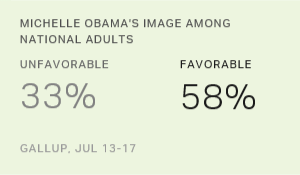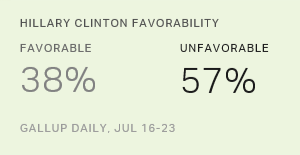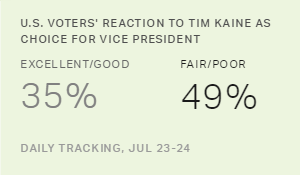Story Highlights
- 44% view Democratic Party more favorably after convention
- 35% were more positive about GOP after its convention
- Clinton's acceptance speech rated better than Trump's
PRINCETON, N.J. -- Americans are evenly divided on whether they view the Democratic Party more favorably (44%) or less favorably (42%) after the party's national convention last week. However, their ratings of the Republican Party after the GOP convention two weeks ago were significantly worse, with 35% saying they viewed the party more favorably and 52% less favorably.
| More favorable | Less favorable | ||||||||||||||||||||||||||||||||||||||||||||||||||||||||||||||||||||||||||||||||||||||||||||||||||
|---|---|---|---|---|---|---|---|---|---|---|---|---|---|---|---|---|---|---|---|---|---|---|---|---|---|---|---|---|---|---|---|---|---|---|---|---|---|---|---|---|---|---|---|---|---|---|---|---|---|---|---|---|---|---|---|---|---|---|---|---|---|---|---|---|---|---|---|---|---|---|---|---|---|---|---|---|---|---|---|---|---|---|---|---|---|---|---|---|---|---|---|---|---|---|---|---|---|---|---|
| % | % | ||||||||||||||||||||||||||||||||||||||||||||||||||||||||||||||||||||||||||||||||||||||||||||||||||
| 2016 Democratic convention | 44 | 42 | |||||||||||||||||||||||||||||||||||||||||||||||||||||||||||||||||||||||||||||||||||||||||||||||||
| 2016 Republican convention | 35 | 52 | |||||||||||||||||||||||||||||||||||||||||||||||||||||||||||||||||||||||||||||||||||||||||||||||||
| Gallup, July 23-24 and July 29-30, 2016 | |||||||||||||||||||||||||||||||||||||||||||||||||||||||||||||||||||||||||||||||||||||||||||||||||||
The results are based on Gallup polls conducted in the days immediately after each party's convention -- the Republican convention in Cleveland from July 18-21 and the Democratic convention in Philadelphia from July 25-28.
Americans' assessments of the effect of the conventions on their image of each party largely mirror their assessments of how the convention will affect their vote in the 2016 election. By 45% to 41%, Americans say they are more rather than less likely to vote for Hillary Clinton based on what they saw or read about the Democratic convention. In contrast, many more Americans said they were less likely (51%) rather than more likely (36%) to vote for Donald Trump as a result of what they saw or read about the Republican convention.
Gallup has asked this question about Democratic and Republican national conventions since 1984, with the exceptions of the 1984 and 1992 Republican conventions. The 2016 Republican convention is the first after which a greater percentage of Americans have said they are "less likely" rather than "more likely" to vote for the party's presidential nominee.
| More likely | Less likely | No difference/No opinion | Net (more likely minus less likely) | |||||||||||||||||||||||||||||||||||||||||||||||||||||||||||||||||||||||||||||||||||||||||||||||||
|---|---|---|---|---|---|---|---|---|---|---|---|---|---|---|---|---|---|---|---|---|---|---|---|---|---|---|---|---|---|---|---|---|---|---|---|---|---|---|---|---|---|---|---|---|---|---|---|---|---|---|---|---|---|---|---|---|---|---|---|---|---|---|---|---|---|---|---|---|---|---|---|---|---|---|---|---|---|---|---|---|---|---|---|---|---|---|---|---|---|---|---|---|---|---|---|---|---|---|---|---|
| % | % | % | pct. pts. | |||||||||||||||||||||||||||||||||||||||||||||||||||||||||||||||||||||||||||||||||||||||||||||||||
| Democratic conventions | ||||||||||||||||||||||||||||||||||||||||||||||||||||||||||||||||||||||||||||||||||||||||||||||||||||
| 2016 | 45 | 41 | 14 | +4 | ||||||||||||||||||||||||||||||||||||||||||||||||||||||||||||||||||||||||||||||||||||||||||||||||
| 2012 | 43 | 38 | 20 | +5 | ||||||||||||||||||||||||||||||||||||||||||||||||||||||||||||||||||||||||||||||||||||||||||||||||
| 2008 | 43 | 29 | 27 | +14 | ||||||||||||||||||||||||||||||||||||||||||||||||||||||||||||||||||||||||||||||||||||||||||||||||
| 2004 | 44 | 30 | 26 | +14 | ||||||||||||||||||||||||||||||||||||||||||||||||||||||||||||||||||||||||||||||||||||||||||||||||
| 2000 | 43 | 28 | 29 | +15 | ||||||||||||||||||||||||||||||||||||||||||||||||||||||||||||||||||||||||||||||||||||||||||||||||
| 1996 | 44 | 29 | 27 | +15 | ||||||||||||||||||||||||||||||||||||||||||||||||||||||||||||||||||||||||||||||||||||||||||||||||
| 1992 | 60 | 15 | 25 | +45 | ||||||||||||||||||||||||||||||||||||||||||||||||||||||||||||||||||||||||||||||||||||||||||||||||
| 1988 | 56 | 21 | 23 | +35 | ||||||||||||||||||||||||||||||||||||||||||||||||||||||||||||||||||||||||||||||||||||||||||||||||
| 1984 | 45 | 29 | 26 | +16 | ||||||||||||||||||||||||||||||||||||||||||||||||||||||||||||||||||||||||||||||||||||||||||||||||
| Republican conventions | ||||||||||||||||||||||||||||||||||||||||||||||||||||||||||||||||||||||||||||||||||||||||||||||||||||
| 2016 | 36 | 51 | 14 | -15 | ||||||||||||||||||||||||||||||||||||||||||||||||||||||||||||||||||||||||||||||||||||||||||||||||
| 2012 | 40 | 38 | 21 | +2 | ||||||||||||||||||||||||||||||||||||||||||||||||||||||||||||||||||||||||||||||||||||||||||||||||
| 2008 | 43 | 38 | 19 | +5 | ||||||||||||||||||||||||||||||||||||||||||||||||||||||||||||||||||||||||||||||||||||||||||||||||
| 2004 | 41 | 38 | 21 | +3 | ||||||||||||||||||||||||||||||||||||||||||||||||||||||||||||||||||||||||||||||||||||||||||||||||
| 2000 | 44 | 27 | 29 | +17 | ||||||||||||||||||||||||||||||||||||||||||||||||||||||||||||||||||||||||||||||||||||||||||||||||
| 1996 | 45 | 34 | 21 | +11 | ||||||||||||||||||||||||||||||||||||||||||||||||||||||||||||||||||||||||||||||||||||||||||||||||
| 1992 | n/a | n/a | n/a | n/a | ||||||||||||||||||||||||||||||||||||||||||||||||||||||||||||||||||||||||||||||||||||||||||||||||
| 1988 | 43 | 27 | 30 | +16 | ||||||||||||||||||||||||||||||||||||||||||||||||||||||||||||||||||||||||||||||||||||||||||||||||
| 1984 | n/a | n/a | n/a | n/a | ||||||||||||||||||||||||||||||||||||||||||||||||||||||||||||||||||||||||||||||||||||||||||||||||
| Gallup | ||||||||||||||||||||||||||||||||||||||||||||||||||||||||||||||||||||||||||||||||||||||||||||||||||||
Since 1984, an average of 45% of Americans have said they are more likely to vote for a party's presidential candidate after the party's convention; thus, the Democratic Party's 2016 convention is right at the historical norm. At the same time, the 41% of Americans who say they are less likely to vote for Clinton after the party's convention is among the highest Gallup has measured, while the 14% who said the convention made no difference in their vote or who had no opinion is historically low.
Americans' ratings of recent conventions have tended to be less positive than those of 2000 and before, likely because of the greater party polarization in Americans' attitudes. That is borne out in looking at the results by political party identification of the 2016, 2008 and 2000 conventions -- all years in which an incumbent was not running in either party. In recent election years, supporters of each party have been more inclined to react positively to their own party's convention, but also much more likely to react negatively to the other party's convention. Fewer in each party now say the other party's convention made no difference to their vote or offer no opinion at all.
| More likely | Less likely | No difference/ No opinion | Net (more likely minus less likely) | |||||||||||||||||||||||||||||||||||||||||||||||||||||||||||||||||||||||||||||||||||||||||||||||||
|---|---|---|---|---|---|---|---|---|---|---|---|---|---|---|---|---|---|---|---|---|---|---|---|---|---|---|---|---|---|---|---|---|---|---|---|---|---|---|---|---|---|---|---|---|---|---|---|---|---|---|---|---|---|---|---|---|---|---|---|---|---|---|---|---|---|---|---|---|---|---|---|---|---|---|---|---|---|---|---|---|---|---|---|---|---|---|---|---|---|---|---|---|---|---|---|---|---|---|---|---|
| % | % | % | pct. pts. | |||||||||||||||||||||||||||||||||||||||||||||||||||||||||||||||||||||||||||||||||||||||||||||||||
| 2016 Democratic convention | ||||||||||||||||||||||||||||||||||||||||||||||||||||||||||||||||||||||||||||||||||||||||||||||||||||
| Democrats/Democratic leaners | 81 | 9 | 10 | +72 | ||||||||||||||||||||||||||||||||||||||||||||||||||||||||||||||||||||||||||||||||||||||||||||||||
| Republicans/Republican leaners | 8 | 82 | 10 | -74 | ||||||||||||||||||||||||||||||||||||||||||||||||||||||||||||||||||||||||||||||||||||||||||||||||
| 2016 Republican convention | ||||||||||||||||||||||||||||||||||||||||||||||||||||||||||||||||||||||||||||||||||||||||||||||||||||
| Democrats/Democratic leaners | 2 | 88 | 10 | -86 | ||||||||||||||||||||||||||||||||||||||||||||||||||||||||||||||||||||||||||||||||||||||||||||||||
| Republicans/Republican leaners | 73 | 13 | 14 | +60 | ||||||||||||||||||||||||||||||||||||||||||||||||||||||||||||||||||||||||||||||||||||||||||||||||
| 2008 Democratic convention | ||||||||||||||||||||||||||||||||||||||||||||||||||||||||||||||||||||||||||||||||||||||||||||||||||||
| Democrats/Democratic leaners | 74 | 8 | 18 | +66 | ||||||||||||||||||||||||||||||||||||||||||||||||||||||||||||||||||||||||||||||||||||||||||||||||
| Republicans/Republican leaners | 8 | 59 | 33 | -51 | ||||||||||||||||||||||||||||||||||||||||||||||||||||||||||||||||||||||||||||||||||||||||||||||||
| 2008 Republican convention | ||||||||||||||||||||||||||||||||||||||||||||||||||||||||||||||||||||||||||||||||||||||||||||||||||||
| Democrats/Democratic leaners | 11 | 70 | 19 | -59 | ||||||||||||||||||||||||||||||||||||||||||||||||||||||||||||||||||||||||||||||||||||||||||||||||
| Republicans/Republican leaners | 78 | 7 | 15 | +71 | ||||||||||||||||||||||||||||||||||||||||||||||||||||||||||||||||||||||||||||||||||||||||||||||||
| 2000 Democratic convention | ||||||||||||||||||||||||||||||||||||||||||||||||||||||||||||||||||||||||||||||||||||||||||||||||||||
| Democrats/Democratic leaners | 67 | 9 | 24 | +58 | ||||||||||||||||||||||||||||||||||||||||||||||||||||||||||||||||||||||||||||||||||||||||||||||||
| Republicans/Republican leaners | 15 | 53 | 32 | -38 | ||||||||||||||||||||||||||||||||||||||||||||||||||||||||||||||||||||||||||||||||||||||||||||||||
| 2000 Republican convention | ||||||||||||||||||||||||||||||||||||||||||||||||||||||||||||||||||||||||||||||||||||||||||||||||||||
| Democrats/Democratic leaners | 22 | 49 | 29 | -27 | ||||||||||||||||||||||||||||||||||||||||||||||||||||||||||||||||||||||||||||||||||||||||||||||||
| Republicans/Republican leaners | 67 | 8 | 25 | +59 | ||||||||||||||||||||||||||||||||||||||||||||||||||||||||||||||||||||||||||||||||||||||||||||||||
| Gallup | ||||||||||||||||||||||||||||||||||||||||||||||||||||||||||||||||||||||||||||||||||||||||||||||||||||
Clinton's Speech Rated More Positively Than Trump's
The most anticipated event at modern political conventions is the presidential nominee's acceptance speech. Overall, 44% of Americans gave Clinton's speech a positive rating, saying it was either "excellent" or "good." That is significantly higher than the 35% who rated Trump's speech positively. In fact, as many Americans rated Trump's speech negatively, saying it was "poor" or "terrible."
Trump's speech was rated less positively than any Gallup has asked about since 1996. The positive rating of Clinton's speech is slightly below the historical average of 47%, but similar to Barack Obama's 2012 acceptance speech. Obama's 2008 speech got the highest percentage of positive ratings at 58%.
| Excellent/Good | Just OK | Poor/Terrible | Didn't see/No opinion | ||||||||||||||||||||||||||||||||||||||||||||||||||||||||||||||||||||||||||||||||||||||||||||||||
|---|---|---|---|---|---|---|---|---|---|---|---|---|---|---|---|---|---|---|---|---|---|---|---|---|---|---|---|---|---|---|---|---|---|---|---|---|---|---|---|---|---|---|---|---|---|---|---|---|---|---|---|---|---|---|---|---|---|---|---|---|---|---|---|---|---|---|---|---|---|---|---|---|---|---|---|---|---|---|---|---|---|---|---|---|---|---|---|---|---|---|---|---|---|---|---|---|---|---|---|
| % | % | % | % | ||||||||||||||||||||||||||||||||||||||||||||||||||||||||||||||||||||||||||||||||||||||||||||||||
| 2016, Clinton | 44 | 17 | 20 | 19 | |||||||||||||||||||||||||||||||||||||||||||||||||||||||||||||||||||||||||||||||||||||||||||||||
| 2016, Trump | 35 | 18 | 36 | 11 | |||||||||||||||||||||||||||||||||||||||||||||||||||||||||||||||||||||||||||||||||||||||||||||||
| 2012, Obama | 43 | 17 | 16 | 23 | |||||||||||||||||||||||||||||||||||||||||||||||||||||||||||||||||||||||||||||||||||||||||||||||
| 2012, Romney | 38 | 21 | 16 | 26 | |||||||||||||||||||||||||||||||||||||||||||||||||||||||||||||||||||||||||||||||||||||||||||||||
| 2008, McCain | 47 | 22 | 12 | 19 | |||||||||||||||||||||||||||||||||||||||||||||||||||||||||||||||||||||||||||||||||||||||||||||||
| 2008, Obama | 58 | 15 | 7 | 20 | |||||||||||||||||||||||||||||||||||||||||||||||||||||||||||||||||||||||||||||||||||||||||||||||
| 2004, Bush | 49 | 19 | 8 | 24 | |||||||||||||||||||||||||||||||||||||||||||||||||||||||||||||||||||||||||||||||||||||||||||||||
| 2004, Kerry | 52 | 19 | 9 | 20 | |||||||||||||||||||||||||||||||||||||||||||||||||||||||||||||||||||||||||||||||||||||||||||||||
| 2000, Gore | 51 | 18 | 6 | 24 | |||||||||||||||||||||||||||||||||||||||||||||||||||||||||||||||||||||||||||||||||||||||||||||||
| 2000, Bush | 51 | 17 | 4 | 28 | |||||||||||||||||||||||||||||||||||||||||||||||||||||||||||||||||||||||||||||||||||||||||||||||
| 1996, Clinton | n/a | n/a | n/a | n/a | |||||||||||||||||||||||||||||||||||||||||||||||||||||||||||||||||||||||||||||||||||||||||||||||
| 1996, Dole | 52 | 21 | 7 | 20 | |||||||||||||||||||||||||||||||||||||||||||||||||||||||||||||||||||||||||||||||||||||||||||||||
| Gallup | |||||||||||||||||||||||||||||||||||||||||||||||||||||||||||||||||||||||||||||||||||||||||||||||||||
Implications
The Democratic Party's convention left a considerably more positive impression on the American public than the Republican Party's convention. That is likely to aid the Democratic Party in its quest to win a third consecutive presidential election. However, the Democratic convention's historically average ratings are beneficial only in contrast to the Republicans' historically negative ratings, meaning both parties could have done a better job of appealing to Americans this year.
In the short term, it appears the Democratic Party will leave the convention phase better off than before it began. Gallup tracking finds Clinton's post-convention favorable rating at 44%, up six percentage points from mid-July. That is much higher than Trump's 32% favorable rating in the days after the Democratic convention. Also, Obama's job approval rating is now up to 54%, tied for the highest it has been since early 2013.
In the weeks ahead, both Clinton's favorable rating and Obama's approval rating could fall back somewhat as the campaign moves further away from the Democratic convention. But as of now, these key election indicators suggest the Democrats are in a stronger electoral position than the Republicans, and Trump and the GOP have a little more than three months left to try to change that.
Historical data are available in Gallup Analytics.
Survey Methods
Results for this Gallup poll are based on telephone interviews conducted July 23-24 (Republican convention) and July 29-30 (Democratic convention), 2016, on the Gallup U.S. Daily survey, with random samples of approximately 1,000 adults each, aged 18 and older, living in all 50 U.S. states and the District of Columbia. For results based on the total samples of national adults, the margin of sampling error is ±4 percentage points at the 95% confidence level. All reported margins of sampling error include computed design effects for weighting.
Each sample of national adults includes a minimum quota of 60% cellphone respondents and 40% landline respondents, with additional minimum quotas by time zone within region. Landline and cellular telephone numbers are selected using random-digit-dial methods.
View survey methodology, complete question responses and trends.
Learn more about how the Gallup U.S. Daily works.


